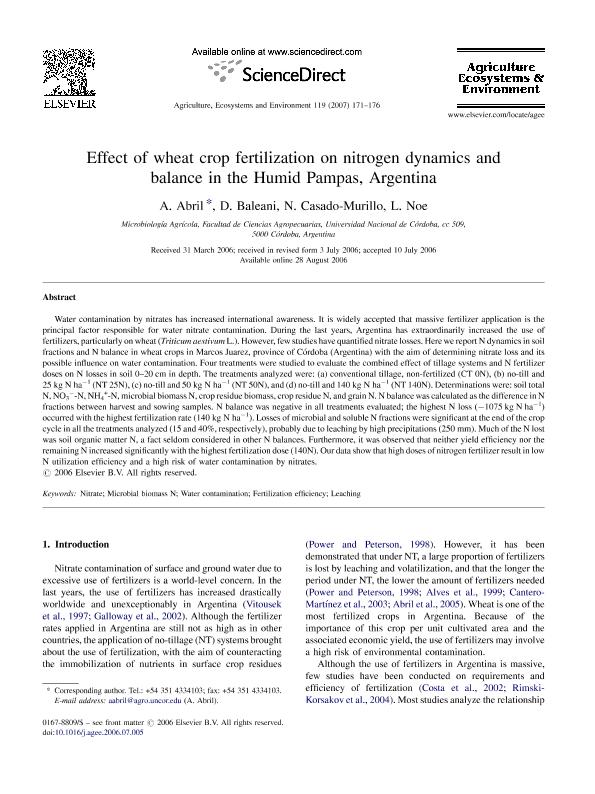Artículo
Effect of wheat crop fertilization on nitrogen dynamics and balance in the Humid Pampas, Argentina
Fecha de publicación:
02/2007
Editorial:
Elsevier Science
Revista:
Agriculture, Ecosystems and Environment
ISSN:
0167-8809
Idioma:
Inglés
Tipo de recurso:
Artículo publicado
Clasificación temática:
Resumen
Water contamination by nitrates has increased international awareness. It is widely accepted that massive fertilizer application is the principal factor responsible for water nitrate contamination. During the last years, Argentina has extraordinarily increased the use of fertilizers, particularly on wheat (Triticum aestivum L.). However, few studies have quantified nitrate losses. Here we report N dynamics in soil fractions and N balance in wheat crops in Marcos Juarez, province of Córdoba (Argentina) with the aim of determining nitrate loss and its possible influence on water contamination. Four treatments were studied to evaluate the combined effect of tillage systems and N fertilizer doses on N losses in soil 0-20 cm in depth. The treatments analyzed were: (a) conventional tillage, non-fertilized (CT 0N), (b) no-till and 25 kg N ha-1 (NT 25N), (c) no-till and 50 kg N ha-1 (NT 50N), and (d) no-till and 140 kg N ha-1 (NT 140N). Determinations were: soil total N, NO3--N, NH4+-N, microbial biomass N, crop residue biomass, crop residue N, and grain N. N balance was calculated as the difference in N fractions between harvest and sowing samples. N balance was negative in all treatments evaluated; the highest N loss (-1075 kg N ha-1) occurred with the highest fertilization rate (140 kg N ha-1). Losses of microbial and soluble N fractions were significant at the end of the crop cycle in all the treatments analyzed (15 and 40%, respectively), probably due to leaching by high precipitations (250 mm). Much of the N lost was soil organic matter N, a fact seldom considered in other N balances. Furthermore, it was observed that neither yield efficiency nor the remaining N increased significantly with the highest fertilization dose (140N). Our data show that high doses of nitrogen fertilizer result in low N utilization efficiency and a high risk of water contamination by nitrates.
Archivos asociados
Licencia
Identificadores
Colecciones
Articulos(CICYTTP)
Articulos de CENTRO DE INV.CIENT.Y TRANSFERENCIA TEC A LA PROD
Articulos de CENTRO DE INV.CIENT.Y TRANSFERENCIA TEC A LA PROD
Citación
Abril, Adriana; Baleani, D.; Casado Murillo, N.; Noe, Laura Belén; Effect of wheat crop fertilization on nitrogen dynamics and balance in the Humid Pampas, Argentina; Elsevier Science; Agriculture, Ecosystems and Environment; 119; 1-2; 2-2007; 171-176
Compartir
Altmétricas




